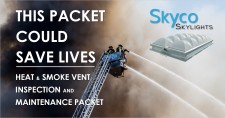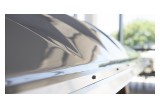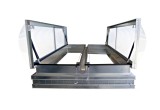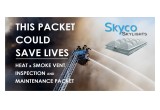Importance of Inspecting and Maintaining Heat and Smoke Vents

Costa Mesa, CA, June 27, 2017 (Newswire.com) - In a recent Roofing Market Survey conducted by Skyco Skylights, “the vast majority of commercial roofers estimated 40 to 60 percent of commercial low-slope roofs are due for re-roof or significant maintenance.” Over half of those roofs have outdated skylights and smoke vents in desperate need of replacement.
Fire Marshals and Fire Inspectors are now utilizing the NFPA 204 Standard for Smoke and Heat Venting, which is referenced in the International Building Code (IBC) and International Fire Code (IFC). Smoke vents are a life-safety device for occupants and firefighters, designed to automatically release the smoke, heat, and hot gases from a burning building in the event of a fire. “In the event of a warehouse fire, it is crucial for smoke vents to work because they are life-saving devices,” says Ryan Marshal, CEO Skyco Skylights.
"In the event of a warehouse fire, it is crucial for smoke vents to work because they are life-saving devices."
Ryan Marshal, CEO Skyco Skylights
Specifically, the NFPA 204, Chapter 12, Inspection and Maintenance Section is the section that Fire Marshals and Fire Inspectors are now following, which provides mandatory guidelines for annual smoke vent inspections.
As per NFPA 204 Standard for Smoke and Heat Venting, “Smoke and heat venting systems and mechanical smoke exhaust systems shall be inspected and maintained in accordance with Chapter 12 [Inspection and Maintenance].” Proper inspection and maintenance are paramount for building owners and facility managers; otherwise, fines and/or replacement may be costly.
The following is an outline of scheduling, inspection and maintenance of existing smoke vents as per NFPA 204.
Requirements: Mechanically opened vents shall be provided with a manual release device. Typically, a cord and handle are used to manually activate smoke vent. This will be used to facilitate the inspection and/or for Fire Fighters to ventilate a burning building quick and safe.
Inspection Schedule: Annual inspection schedules for each smoke vent shall be written out detailed with dates and procedures. Any special mechanisms, such as gas shocks, shall be inspected individually each year or as specified by the manufacturer.
Details to Note
- Changes in appearance
- Damage to any components
- Fastening security
- Weather tightness
- Adjacent roofing and flashing condition
- Any deficiencies
- Any other pertinent items
Inspection Actions and Details
- Doors shall be activated by pulling on manual release. Latches should immediately release smoothly and open moving through its designed travel. Doors should open fully without assistance or interruption which would indicate a faulty piston, sticking weather seal, or corroded bearings.
- With doors open, inspect the restraining cable system. Cabling should have ample tension and no frays. Observation shall be made of the whip and travel path of cable, noting any possible obstruction that would delay release of the doors. Any interference shall be corrected by removing obstruction and noted immediately.
- All operating levers, latches, hinges and weather-sealed surfaces shall be examined to determine conditions, such as deterioration and accumulation of foreign materials. An operational test shall be performed after removal or correction of any issues.
- Inspect the fusible link to determine the date and temperature rating stamped on each fusible link. Fusible links have a life expectancy of 5 years. If during the inspection the fusible link is 5 years or older, it must be replaced with a new fusible link with the identical temperature rating.
- Temperature setting shall be set at a temperature that does not interfere with any sprinkler or first response systems. i.e. Temperature must be set higher than temperature response setting for sprinklers so sprinklers can engage as designed.
Reporting: Upon completion of the inspection, an inspection report shall be provided to the Facilities Manager, and maintained on file by the local Fire Inspector. Each vent shall also have an inspection tag attached, indicating date, who inspected and results of inspection.
Maintenance: It’s highly advised to consult a skylight and smoke vent professional when it comes to any maintenance on units. Manufacturers like Skyco Skylights in Costa Mesa, CA are able to direct maintenance on various items to address. In most cases, a new unit is the best and safest option. If you choose to perform maintenance on your units always make sure every item works 100% and do not conflict with other parts. It should be noted that dome only change outs on smoke vents may void the UL Listing and create unintentional liability for the building owner.
Smoke vents are life saving devices. A regular, diligent inspection and upkeep program is needed to ensure the units perform as designed. It is up-to building owners and facilities managers to keep their units in working shape. Inspectors will periodically check in and issue orders to replace or fix.
Source: Skyco Skylights



